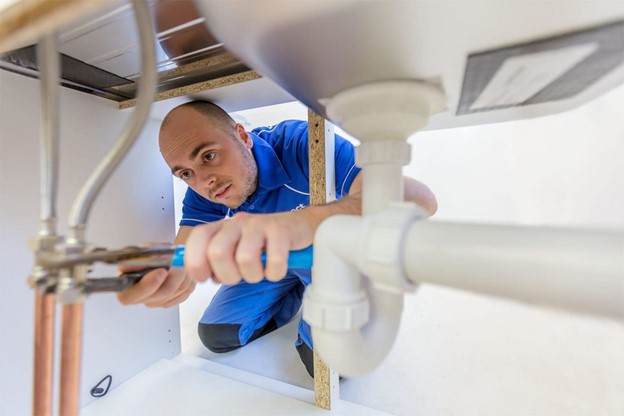Whether building a new house or renovating an existing one, plumbing is essential to any construction project. Properly installed plumbing ensures that your home’s plumbing system is functional and efficient, preventing costly repairs down the road.
Here are some tips to provide the best plumbing installation in your new home.

1. Planning is Essential
When it comes to plumbing installation, planning is critical. Before beginning work on your project, have the plan to ensure everything gets installed correctly and safely. Make sure to consider the size of pipes needed for your project and other factors such as water pressure and local codes. It will help ensure that the project runs smoothly and efficiently from start to finish.
2. Permits
Before building a plumbing system, you must seek and receive the necessary permissions. While processing everything may take some time, obtaining permits will guarantee that your property complies with all safety regulations and code standards. A permit enables experts to evaluate and check any errors in your plumbing design.
3. Plumbing Needs
When building a plumbing system, it is vital to consider your current and future plumbing demands. To ensure operation, you must select where to place your drain lines, plumbing, and sewer. While you still have easy access to it, include all current and future water demands into your plumbing system to save money on future repairs.
To have adequate outdoor plumbing faucet connections you can utilise throughout your property, you also need to consider your outdoor plumbing demands. Consider the seasons to ensure that your pipes are strong and will last despite severe weather, especially during the winter.
4. Centralise the Plumbing Infrastructure
Establishing the best plumbing system with everything in one location is essential to simplify future maintenance and repairs. The following are some of the appliances you should install collectively:
- Water Heater
- Sewage Ejector Pit
- Sump Pump
- Sewer Connection
- Water Softener
- Furnace
As the most suitable location to build your system without becoming an eyesore, you may install these components together in the basement. If you don’t have a basement, place them on the main level and keep them neatly hidden inside a utility closet.
5. Think about Water Softeners
Installing water softeners will be ideal for your home if you have problems with hard water. Even if you aren’t currently experiencing issues, consider installing one to deal with problems of this nature in the future. Water softeners may be challenging to install in the future, so install one now to avoid paying extra fees later.
Always consider the long-term when installing a plumbing system for your home. By planning, you may save money and spare yourself the hassle of installing new equipment for your system.
6. Share Wet Wall
Sharing a moist wall might help you save money when building a house. A damp wall is precisely what? The vent stacks, water supply pipes, and sewer lines are behind a wet wall. Homes usually have separate wet walls for the kitchen and bathroom. However, sharing a wet wall might save you money. You can design a plan where the kitchen and laundry room share a damp wall or the bathrooms share a border.
A shared wet wall might help you save money since it will require less labour and resources. If your plumbing pipes are all in one location, maintaining and repairing them will also be simpler.
7. Placement of Accessible Shut-Off
You might want quick access to your primary shut-off valve in an emergency. While others usually put them in difficult-to-reach places, you ought to choose a location with simpler access. It allows you to instantly turn off your plumbing system in case of a leak or a burst pipe or even when you need to do a routine maintenance check. If you have easy access to the main valve for your plumbing system, you can avoid significant water damage and save money.
8. Carefully Select Materials
The materials used for your plumbing installation are just as necessary as the installation itself. It’s essential to select materials that are appropriate for your specific needs—for example, water pressure or temperature requirements—and those that meet local building codes and regulations. Make sure to research different materials available and consult a professional before selecting.
9. Consider Water Flow Direction
The direction of water flow is essential in keeping the system running correctly and efficiently. Consider this when designing or installing your system; incorrect water flow direction can lead to inefficient performance or even cause damage over time due to strain on pipes or fixtures caused by backflow or poor drainage capacity. Consulting with a professional plumber in Burwood https://doyleplumbinggroup.com.au/plumber-burwood/ can help determine water flow direction for optimal results.
10. Use Quality Fixtures & Pipes
Install quality fixtures and pipes throughout the system for optimal performance over time; cheaper alternatives could cost more money in repairs down the line due to premature wear-and-tear or other issues caused by substandard materials being used instead of quality ones. Investing in high-quality components can save you money later on maintenance costs associated with shoddy products being used instead of quality ones initially installed during construction/installation.
Connect with Professional Doyle Plumbing Experts.
With these essential tips, you will have no problem installing plumbing in your new home! Remember to hire professional Doyle Plumbing experts and carefully select material types that meet local building codes/regulations while considering water flow directions throughout the system (for optimal results). Use quality fixtures & pipes throughout the entire system (to prevent costly repairs down the line) – these steps will help ensure the best possible outcome!

